 The past decade, we’ve seen huge strides in diversity, equity and inclusion (DEI). Conversations about DEI were once mere notions of a brighter future, but now these discussions are more of a commonplace fixture in organizations. Despite these efforts, real-world inclusion practices can sometimes still seem like a pipe dream—we know we need it, but we’re not entirely sure how to actually accomplish it.
The past decade, we’ve seen huge strides in diversity, equity and inclusion (DEI). Conversations about DEI were once mere notions of a brighter future, but now these discussions are more of a commonplace fixture in organizations. Despite these efforts, real-world inclusion practices can sometimes still seem like a pipe dream—we know we need it, but we’re not entirely sure how to actually accomplish it.
Luckily, DEI leaders are pioneering ways to foster inclusion and drive continuous improvement. In a recent webinar, Traci Sewell, director of Sewell Consulting and DEI lead at SQLBits, chatted with Hannah Lloyd, vice president of channel sales with In-Soc and chair of the CompTIA Community – UK & Ireland DEI Interest Group, about her efforts to make DEI more commonplace.
Normalizing DEI
Sewell makes it her life’s work to promote inclusion in the workplace, but she stressed that the path to normalization hasn’t been an easy one and we still have huge obstacles to overcome. You can’t begin to normalize DEI from a negative perspective, but rather with a positive approach, she said.
“DEI was a buzz word pre-pandemic that scared a lot of people, where conversations were opened by telling them all the things they were doing wrong,” Sewell said. “It’s actually much more about making your workplace, conference or environment as equitable and inclusive as it can be … it’s about not pushing anyone out of the mainstream for any reason.”
Sewell urges that inclusion is a practice that turns everyone into heroes.
“For a long time, anything that made you different was seen by people as a weakness,” Sewell noted. “Changing that conversation is huge.” To stress the importance of this notion, Sewell extends her inclusion umbrella to go beyond gender and race to include those with physical disabilities, the LGBTQ+ community, those experiencing illness, neurodivergent learners and even those dealing with grief, among others. She finds ways to showcase unique perspectives as superpowers and supports anyone who wrestles with the day-to-day rhythm of nonstandard situations.
Practicing Inclusion in a Real Setting
Sewell’s own experiences as a cancer survivor brought her face-to-face with the need for better, richer DEI practices. She saw firsthand that moving the needle would mean so much more than diversifying so that numbers meet quotas.
Emotional Support
One of the first measures Sewell implemented at her conferences was emotional support. Her own battles made her aware that attendees were often wrestling with issues that originated outside of the office. To provide services for those dealing with emotional issues, she placed an on-call psychotherapist at conferences. She initially expected to receive two or three inquiries but was surprised when 35 sessions were conducted during the seven-day conference.
“I covered everything from the death of a family member all the way through mental health issues and anxiety for someone coming out to their parents,” she said. “I even spent 18 months working with someone who was on the verge of ending their life.”
Self-Identification
Another measure that Sewell found to be very helpful was stickers to showcase different forms of self-identification. These ranged from pronoun stickers so that attendees could easily address one another by their chosen pronouns to color-coded stickers for those who have been affected by illness. The color-coded stickers allowed people to identify whether they were dealing with a medical issue or supporting someone affected by illness.
Sewell’s goal was to foster conversations to avoid feelings of loneliness associated with medical struggles. “By the end of the event, we have what’s called an emotion board which creates connection and starts conversation to break uncomfortable taboos,” she said.
Places for Everyone
Sewell also finds that it is possible to make a safe place for everyone. In addition to promoting common DEI initiatives, such as gender awareness and racial inclusion, she wanted to provide spaces for those of different religions and those without childcare. She instituted a multi-faith space where people of all religions could access worship as well as a creche to provide on-site childcare services.
“Statistically, it is more likely that the female of a relationship will be the major childcare provider and that puts a barrier in place so they wouldn’t be able to speak or attend our conference,” she said. “Introducing a creche meant that women who had childcare problems now don’t.”
Representation
Sewell believes that true inclusion doesn’t just involve participation, but also representation. That’s why she strives to include speakers from diverse backgrounds who can offer unique perspectives and stories. She believes that seeing someone like yourself act as a leader will break down barriers for those outside of the mainstream.
“Once you increase visibility, you start to increase understanding,” she said. “That then encourages more people, who see themselves, to strive to be a part of these things.” She encourages that sharing experiences is vital for growth. “I would love to see parity across the board … of all underrepresented groups who for so many years have been discriminated against and yet bring such a rich tapestry of information and experience and empathy and understanding to the environment.”
Encourage Conversations
Sewell has seen the power of open conversations when it comes to eliminating discomfort and bolstering morale. To encourage those types of conversations, she started with the conference’s code of conduct.
“I completely rewrote the code of conduct for the conference so that it took away as much of the detail about all the things you can do wrong,” she noted. “It opens up the conversation.” Instead of outlining all the ways wrongdoing could manifest, she put a color-coded warning system in place to identify when attendees had overstepped (yellow for a warning, amber denotes an elevated warning with the potential for expulsion, and red is a request for removal). The new code also implemented a system that made it easy to report issues, helping to resolve conflicts more quickly. Beyond those updates, Sewell also introduced sessions dealing with soft skills based on attendee feedback, tackling topics such as workplace burnout and mental health issues.
Ultimately, Sewell encourages organizations to find ways to make DEI part of the everyday, rather than operating in a silo.
“I would love to see a day when we don’t have to go through submissions for speakers to make sure that we’re bringing the numbers up,” she said. “It’s much more about making sure that happens organically.”
Want to join the DEI discussion?
Connect with your regional group within the CompTIA Community.

 Add CompTIA to your favorite RSS reader
Add CompTIA to your favorite RSS reader

